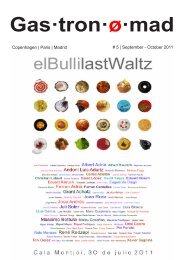Gastronomad #9 May-June 2012
You also want an ePaper? Increase the reach of your titles
YUMPU automatically turns print PDFs into web optimized ePapers that Google loves.
BØN·APPETIT<br />
Corn, Mexico’s gold<br />
Maíz, el oro de Méjico<br />
Ancient<br />
legend tells us that in the beginning, the Aztec people<br />
mainly subsisted on roots and animals. They<br />
didn’t understand the significance of corn because it<br />
was hidden behind the mountains. The gods tried to<br />
open a road to the source of the corn but were unsuccessful.<br />
The god Quetzalcoatl decided to transform<br />
himself into a black ant and, accompanied by a<br />
red ant, marched towards the mountains. Upon their<br />
return, they brought grains of corn to the people who<br />
greeted them with great enthusiasm.<br />
The history of corn in Mexico goes back over 7000<br />
years near the Teotihuacan valley, where its earliest<br />
trace has been discovered. Being one of the<br />
first grains domesticated by humans, it is believed<br />
that corn production is the beginning of agriculture in<br />
the region. Since this early beginning, the Mexican<br />
peasant has played a key part in the development<br />
of different breeds of local corn, which have been<br />
adapted to all types of soil and climate. By the process<br />
of selecting the best seeds, the cultivation of<br />
the crop spread rapidly across America and eventually<br />
all around the world.<br />
4 Gas�tron�ø�mad<br />
Cuenta<br />
�: Cristina C. | �: El pueblo del Maiz<br />
la leyenda que en el principio, el pueblo azteca se<br />
alimentaba de raíces y animales que cazaban. No<br />
conocían el maíz, ya que estaba escondido tras<br />
las montañas. Los dioses intentaron abrir camino a<br />
base de fuerza pero no pudieron, es por ello que el<br />
dios Quetzalcóatl decidió transformarse en hormiga<br />
negra y acompañado de una hormiga roja, emprendió<br />
el arduo viaje a través de las montañas. A su<br />
regreso, trajo consigo granos de maíz, el cual fue<br />
recibido por su pueblo con gran júbilo.<br />
La historia del maíz en México data a más de 7000<br />
años atrás, cerca del valle de Teotihuacán donde se<br />
han encontrado sus vestigios más antiguos. Siendo<br />
un de los primeros cereales domesticados por<br />
el hombre, se cree que su producción es el inicio<br />
de la agricultura en la región. Desde ese entonces,<br />
el campesino mexicano ha jugado una parte fundamental<br />
en el desarrollo de más de diversas razas de<br />
granos de maíz de forma local, los cuales han ido<br />
adaptándose a todo tipo de suelo y clima a través de<br />
la selección de las mejores semillas, extendiéndose<br />
rápidamente a toda América y el resto del mundo.













